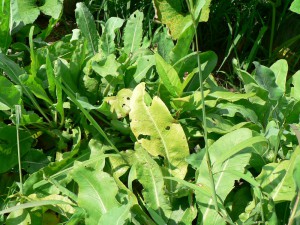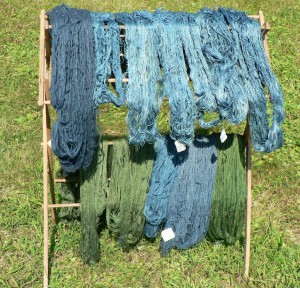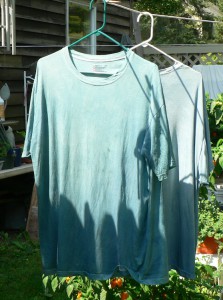Yesterday I picked 8 and a half pounds of woad leaves. This is a lot, probably the largest quantity I’ve harvested at one time. Many of the leaves are droopy and yellow at this point in the summer. It has been hot and dry, but there is a lot of color in them, so no worries.
I had written earlier in the summer about woad’s enemies. To fend off the cabbage whites, I planted two hyssop plants, which are supposed to help. I could only find anise hyssop, which may or may not be the right type. It definitely attracts the adult butterflies, as a food source I suspect. But I’m not sure it keeps them from laying eggs on the woad, and it’s the caterpillars that eat the woad leaves, not the butterflies.
I think at this point in the summer that slugs are the main predator on the woad, but I did find quite a few cabbage white eggs. The hyssop is very pretty, though, and it smells great, and the woad is doing OK, so even if the cabbage whites are still laying eggs on it, I guess it’s all fine.
I made my usual ammonia-hydrosulfite vat. My main goal was to dye some 40/2 linen to weave bookmarks with a snowflake motif for the winter season, and some 10/2 cotton for book cloth. I have been struggling with cellulose fibers, in terms of getting the depth and consistency of color that I want, but feel that I am getting somewhere and improving my techniques, which is satisfying. Yesterday I used the ratios for anionic (12/24/2023 Correction! Cationic!) scour and soda ash recommended by Earthues for scouring cellulose fibers, but I followed the general recommendation in Jim Liles’ book to scour linen for an hour and cotton for at least two. So, I used 5.5% WOG (weight of the goods, or yarn) anionic (cationic) scour and 2% WOG soda ash, and simmered the linen and cotton yarns together in the same pot for an hour. Then I pulled them out, rinsed them, and made a fresh scouring pot at the same percentages as the first one, and simmered for another hour. Then I rinsed them again, and proceeded with dyeing.
I haven’t rinsed my dyed skeins yet because I always let them dry completely first, but here’s a photo of them hanging up to dry and they look very promising indeed. In fact, the blue on the 40/2 linen (farthest top right) may be a little too dark for snowflakes. It’s not exactly icy.
The cellulose yarns are on the top rack, not including the last skein on the left. The super-dark skein on the upper left is an over-dyed skein of rug wool, and all the yarns on the bottom are wool. The green on the bottom right is woad over Queen Anne’s Lace (whole plants), and the two green skeins on the bottom left are woad over yarrow.
I normally can’t keep my woad vats going for a second day. Usually they get exhausted within a few hours, and once it cools down the chemistry gets all messed up. Today however, I have dyed two more skeins of wool and two t-shirts.
Over the years, I have dyed several t-shirts for Matthew to wear to fend off Romans, or their modern day equivalents. Periodically they get re-dyed, though these two may be on their last legs. Eventually the cloth just wears out. I am not a whiz at dyeing fabric so they are always a bit splotchy, but the go-away-Romans message is still clear.





Romanes Eunt Domus!
http://www.youtube.com/watch?v=IIAdHEwiAy8